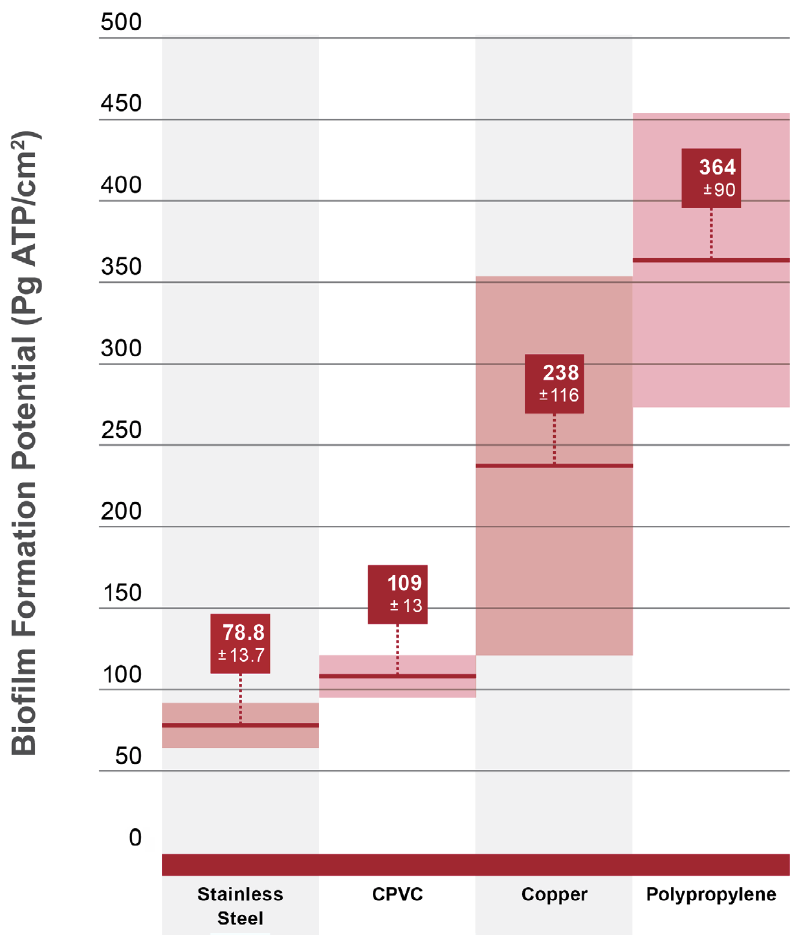Health Risks Caused by Plumbing, and How to Prevent Them
Water safety leads to healthier homes and healthier, safer families. Improper use of plumbing materials can lead to water supply issues, either due to improper installation or the specification of unsuitable plumbing materials entirely.
Every material your water supply comes into contact with may have an effect on it; therefore, it is important to know the risks associated with plumbing materials in the delivery of safe, clean water.
This is why FlowGuard® CPVC is designed to help minimise the threats associated with waterborne bacteria and contaminants. Its installation methods help ensure safe delivery of water to the homes, families and communities that need it around the world.
Let's take a closer look at some of the health risks associated with plumbing and some of the best ways to avoid them.
Biofilm Contamination
Legionella bacteria
Legionella bacteria is a common byproduct of biofilm formation. Inside plumbing pipes, if conditions are suitable for biofilm growth, legionella is arguably the principal risk. This bacteria can lead to potentially life threatening illnesses like legionnaires disease. Legionella bacteria can also cause Pontiac fever in those exposed; this is a rare, flu-like illness, dangerous because it is often mistaken for ordinary flu, which is why so many of its sufferers do not consider their water supply to be potentially contaminated.
Pseudomonas
Pseudomonas are another form of harmful bacteria which can lead to severe illnesses, particularly in those with weaker immune systems. Like legionella, it thrives on the healthy development of biofilm, a common threat to plumbing pipes. Pseudomonas can also thrive on natural organic nutrients found in water, as well as stagnant water, which has been allowed to remain still for extended periods of time.
Biofilm formation is the most likely cause of legionella growth in domestic plumbing pipes. Layers of biofilm can form on the interior surface of plumbing pipes and play host to a thriving environment for multiplying bacteria, including legionella. Plumbing pipes such as PPR can inadvertently provide a suitable natural environment for biofilm through which legionella can develop. This could be due to internal beading caused from the joining process.
To minimise the threat of legionella, pseudomonas and other related harmful bacteria, you must minimise the development of biofilm.
FlowGuard CPVC is not conducive to biofilm growth and minimises the threat of developing harmful bacteria like pseudomonas, legionella and more, as demonstrated in the Kiwa water assessment. This confirms CPVC has significantly reduced potential for biofilm formation, compared to other piping materials, including PPR.

Bacteria can be introduced to a plumbing system from a variety of unavoidable sources. No piping system will prevent bacterial growth, however disinfectants such as chlorine, chloramine and chlorine dioxide are commonly added to the water supply to help combat the growth of bacteria in water.
Unfortunately, these disinfectants can cause serious problems for PPR and copper plumbing systems.
Chlorine incompatibility
Chlorine is a common disinfectant in water supplies; however, it can degrade certain plumbing systems. For example, the chlorine present in common potable water can react with PPR pipe material over time, causing the material to become weaker, leading to system defects and inevitable pipe system failure.
FlowGuard CPVC is not affected by chlorine and chlorine dioxide commonly found in potable water distribution systems, as demonstrated by the below pictures, comparing the resistance of CPVC and PPR pipe against hot chlorinated water:

Leaks in plumbing systems
Plumbing systems that are not optimised for water safety can also lead to health risks outside the plumbing system itself. For example, leaks in plumbing systems can lead to mould and mildew growth, leading to respiratory health risks as well as skin related illnesses. Exposure to pathogens throughout the home can trigger respiratory health risks, such as asthma or allergic reactions.Beyond the health risks associated with the water supply itself, leaks caused by a failing plumbing system can lead to critical structural issues throughout the home if they are not dealt with early; this can provide an unsafe environment for families, including the heightened risk of electrical hazards and fires.
FlowGuard CPVC has a reliable and flexible installation process that allows for optimum system installation throughout the family home; this helps plumbers to optimise system performance and minimise the risk of structural damage or leaks. CPVC itself is designed for decades of fault free water distribution and is proven to be less prone to corrosion when compared to PPR.
FlowGuard CPVC is optimised for water safety thanks to its durability, smooth interior surface, temperature and pressure resistance and inherent compatibility with water supplies around the world.
Learn more about the importance of delivering water safety with safe, reliable plumbing materials in our water safety video presentation.
.png)
-1.png)